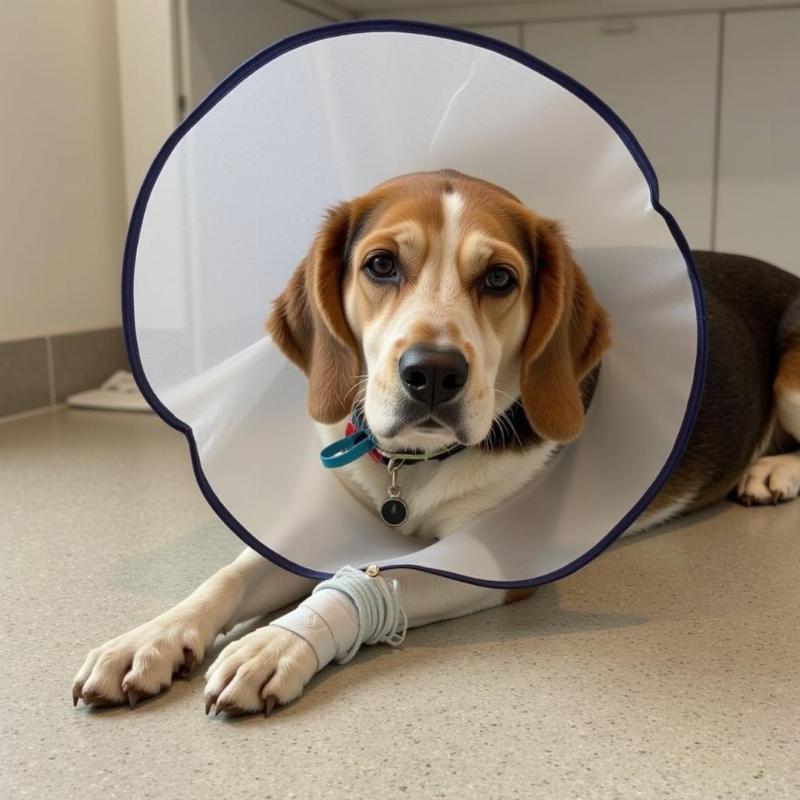Recovering from TPLO (Tibial Plateau Leveling Osteotomy) surgery is a significant journey for both you and your furry friend. Understanding what to expect after the procedure is crucial for a smooth and successful recovery. This guide provides comprehensive information on post-operative care, pain management, physical therapy, and potential complications to help you navigate this important period.
Post-Operative Care: The First Few Weeks
Immediately after surgery, your dog will be groggy and disoriented due to anesthesia. The veterinary team will provide detailed instructions for at-home care, including medication administration, wound management, and activity restrictions. Strict rest is essential during the initial two weeks to allow the surgical site to heal. This means confining your dog to a small, safe space and preventing jumping, running, or playing. Short, leashed potty breaks are permitted.  Dog recovering after TPLO surgery
Dog recovering after TPLO surgery
Managing Pain and Discomfort
Pain management is a critical aspect of post-operative care. Your veterinarian will prescribe pain medications and anti-inflammatories to help manage your dog’s discomfort. It’s crucial to administer these medications as directed and to monitor your dog for any signs of pain or adverse reactions. Signs of pain can include whining, restlessness, decreased appetite, and reluctance to move. Contact your vet immediately if you observe any of these symptoms.
Physical Therapy and Rehabilitation
Physical therapy plays a vital role in restoring your dog’s mobility and strength after TPLO surgery. Your veterinarian may recommend specific exercises or refer you to a certified canine rehabilitation therapist. These exercises, which may include controlled leash walks and range-of-motion activities, should be introduced gradually and under the guidance of a professional.
Monitoring for Complications
While TPLO surgery is generally safe and effective, complications can occasionally occur. These may include infection, implant failure, or slow healing. Regular check-ups with your veterinarian are essential to monitor your dog’s progress and address any potential issues promptly. Observe your dog for any signs of swelling, redness, discharge, or lameness at the surgical site. dog tplo surgery recovery timeline provides a detailed overview of the recovery process and potential complications.
Long-Term Recovery and Expectations
Full recovery from TPLO surgery typically takes several months, with most dogs regaining near-normal function within six to eight months. However, the recovery timeline can vary depending on the dog’s age, breed, size, and overall health. complications of tplo surgery in dogs explains the potential risks associated with the procedure. During the recovery period, it’s essential to continue following your veterinarian’s instructions regarding activity restrictions, medication, and physical therapy. Patience and consistency are key to a successful outcome.
When Can My Dog Climb Stairs?
Climbing stairs is a common concern for owners of dogs recovering from TPLO surgery. Generally, stairs should be avoided for at least eight weeks post-surgery. when can my dog climb stairs after tplo surgery provides detailed guidance on reintroducing stair climbing. When your dog is ready, introduce stairs gradually, starting with a few steps and using support if needed. Never allow your dog to run up or down stairs.
Returning to Normal Activity
Gradually reintroducing normal activity is crucial to avoid re-injury. Follow your veterinarian’s recommendations for increasing exercise intensity and duration. Avoid high-impact activities like running and jumping for several months. tplo surgery dog recovery time offers a detailed timeline for returning to various activities. Remember that every dog is different, and the recovery process may take longer for some. Be patient and supportive throughout the journey. tplo surgery for dogs recovery provides further information on the long-term recovery process and management.
Conclusion
TPLO surgery can significantly improve your dog’s quality of life by stabilizing the knee joint and alleviating pain. By understanding what to expect after surgery and following your veterinarian’s instructions diligently, you can help ensure a smooth and successful recovery for your beloved companion. Remember, patience, consistency, and a positive attitude are crucial throughout this journey.
FAQ
- How long does it take for a dog to recover from TPLO surgery? Full recovery generally takes six to eight months, but it can vary.
- What are the signs of TPLO surgery complications? Signs include swelling, redness, discharge, lameness, or pain at the surgical site.
- When can my dog start physical therapy after TPLO surgery? Your veterinarian will advise on the appropriate time to begin physical therapy.
- How can I manage my dog’s pain after TPLO surgery? Administer prescribed pain medications as directed by your veterinarian.
- What are the long-term expectations after TPLO surgery? Most dogs regain near-normal function and enjoy an active lifestyle.
- Can my dog run and jump after TPLO surgery? High-impact activities should be avoided for several months following surgery.
- What should I do if I notice any unusual signs after TPLO surgery? Contact your veterinarian immediately.
Beautdogs.us is your premier destination for all things dog-related in the US. We offer expert advice on dog breeds, care, and products, providing a trusted resource for both new and experienced dog owners. Our passion is helping you provide the best possible care for your furry friend. Contact us for any questions or assistance. Email: [email protected], Phone: +1 501-555-7529. Visit Beautdogs.us for more valuable insights.